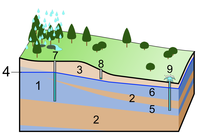
Photo from wikipedia
Deterioration of groundwater quality due to the introduction of pollutants from natural and anthropic sources has become a major environmental issue. We tested three methodologies in assessing groundwater quality and… Click to show full abstract
Deterioration of groundwater quality due to the introduction of pollutants from natural and anthropic sources has become a major environmental issue. We tested three methodologies in assessing groundwater quality and intrinsic aquifer vulnerability in the Agro-Aversano area (Southern Italy). A geographic information system (GIS)-based groundwater quality index (GQI) was realized to assess groundwater quality for drinking and irrigation use and, in parallel, standard SINTACS was applied to evaluate the intrinsic vulnerability of the aquifer. Nitrate concentrations and sodium absorption ratio (SAR) in groundwater samples were used to verify the reliability of vulnerability data. GQI analysis pointed to a general poor quality of groundwater both for drinking and irrigation use, especially in sub-urban areas. The spatial pattern of water quality from GQI analysis was positively related to nitrate and fluoride concentrations for drinking use and to bicarbonate and sodium concentrations for irrigation use, whose levels exceeded the WHO and FAO recommended thresholds, respectively. Standard SINTACS was found to be inadequate for describing the aquifer state, its results showing no correlation with nitrate concentration or SAR. Because of this inconsistency, we tested a novel approach combining GQI with SINTACS analysis. Results showed positive correlation with nitrate (r = 0.63) and SAR (r = 0.64) contents, thus pointing to combined SINTACS-GQI as a more reliable approach than standard methodologies.
Journal Title: Environmental Monitoring and Assessment
Year Published: 2019
Link to full text (if available)
Share on Social Media: Sign Up to like & get
recommendations!